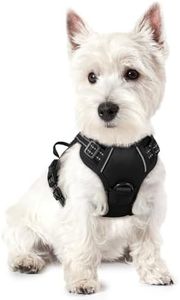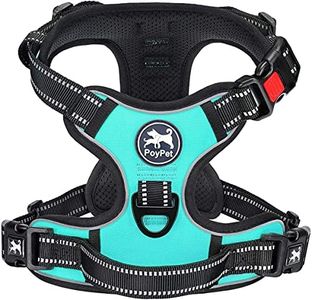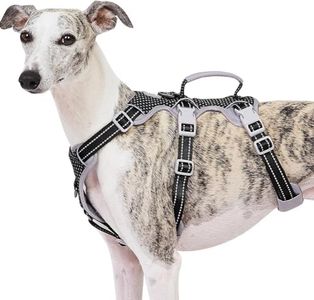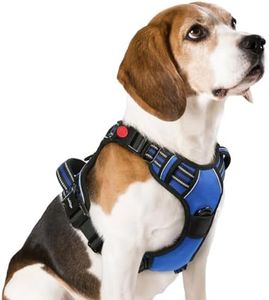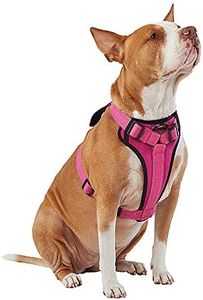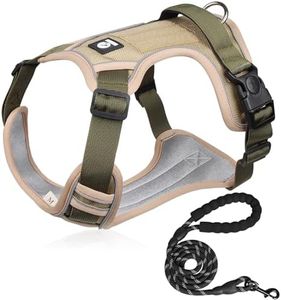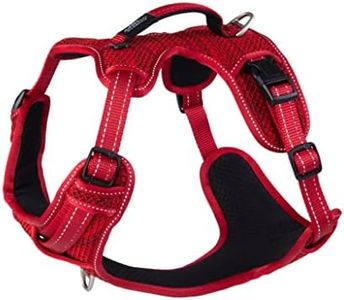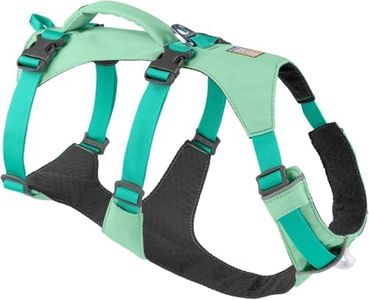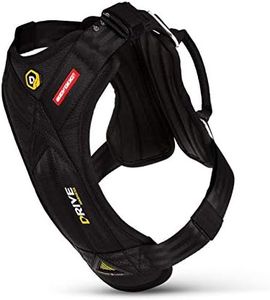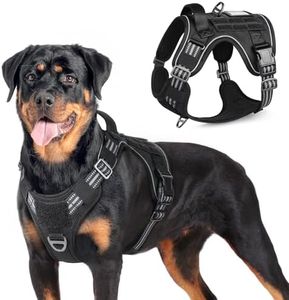We Use CookiesWe use cookies to enhance the security, performance,
functionality and for analytical and promotional activities. By continuing to browse this site you
are agreeing to our privacy policy
10 Best Dog Harnesses
From leading brands and best sellers available on the web.By clicking on a link to a third party's website, log data is shared with that third party.
Buying Guide for the Best Dog Harnesses
Choosing the right dog harness is important for both your dog's comfort and your control while walking or training. Harnesses help distribute pressure more evenly across your dog's body than a collar, which can help prevent neck strain or injury. The best fit will depend on your dog's breed, size, activity level, and specific needs. When shopping, it's important to pay attention to key features so you can find a harness that will be comfortable, safe, and easy to use for both you and your dog.Harness TypeThere are several types of harnesses including step-in, vest, no-pull, and front-clip harnesses. The harness type determines how you put it on your dog and how much control you have. Step-in harnesses are easy to put on, which can be good for calm or smaller dogs, while vest styles offer more padding and can be more comfortable for longer walks or for dogs with sensitive skin. No-pull and front-clip harnesses are designed to discourage pulling, making them useful for training or for dogs that tend to tug during walks. Think about your dog's behavior and your needs when choosing the type: calm dogs may do fine in any harness, while energetic or training dogs may benefit from a no-pull option.
MaterialHarnesses are made from materials such as nylon, mesh, leather, and neoprene. The material affects durability, comfort, and breathability. Nylon is strong and lightweight, mesh is breathable for hot climates, leather is durable and softens over time, and neoprene offers extra softness and padding but may be less breathable. Consider your local climate, your dog's skin sensitivity, and how often you’ll use the harness to pick the right material.
AdjustabilityAdjustability refers to how much you can change the size of the harness to fit your dog. A good harness will have several adjustable points, usually around the chest, neck, and sometimes the belly. More adjustability means a better fit—important for dogs that are still growing, unusual body shapes, or if your dog wears coats underneath. Always measure your dog according to the manufacturer's sizing guide and pick a harness you can adjust to your dog's unique shape.
PaddingPadding provides extra comfort and can prevent rubbing and irritation, especially during longer walks or for dogs with sensitive skin. Some harnesses have extra padding on the chest and stomach, which is useful if your dog tends to pull or if you use the harness for running or active outings. If your dog is comfortable in basic harnesses and only takes short walks, less padding might be fine. For more active dogs, older dogs, or those with sensitive skin, more padding may be preferable.
Clip LocationClip location refers to where the leash attaches to the harness. Front-clip harnesses discourage pulling by turning your dog when they pull, while back-clip harnesses are simple and good for calm, well-trained dogs. Some harnesses offer both front and back clips, making them versatile for different situations. If your dog pulls a lot, look for a front-clip or dual-clip harness; if your dog is easy to walk or mostly walks off-leash, a back-clip may be enough.
Security and Escape-Proof FeaturesSome dogs are good at slipping out of harnesses, especially slender or flexible breeds. Escape-proof features like extra belly straps or specially designed closures help prevent a dog from backing out of the harness. Dogs that are strong, anxious, or known escape artists may benefit from these features, while others with calm temperaments may not need them.
Ease of UseEase of use covers how easy it is to put the harness on and take it off, as well as adjusting it for fit. Some harnesses have quick-release buckles or step-in designs that make them more convenient for daily use. If you have a wiggly or impatient dog, or need to put the harness on quickly, look for a design that is simple and fast to attach.
Visibility FeaturesFeatures like reflective strips or bright colors make your dog more visible during low light walks. If you walk your dog early in the morning, in the evening, or near traffic, high-visibility features are important for safety. For daylight-only or backyard use, this spec may be less important.

